5 Different Types Of Cast Iron Cookware for Your Home
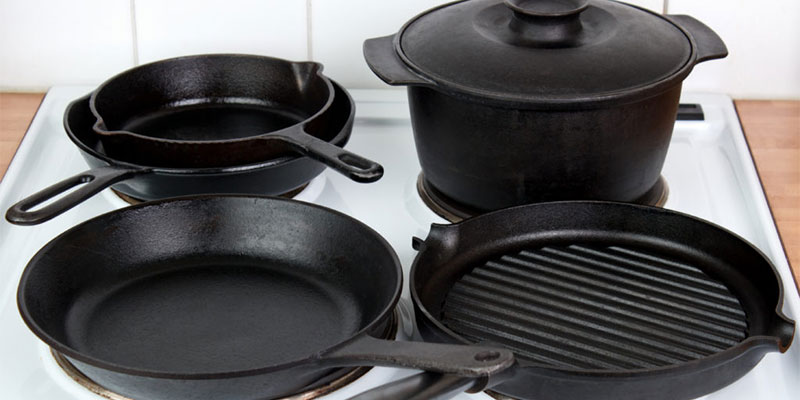
Cast iron pans are sometimes referred to as the ‘king’ of the kitchen appliances. Chances are you’re going to get one for yourself. There are different types of cast iron cookware in the market, so you may find it difficult to choose one.
You are not alone. People have been using these pans for years. There are a lot of things you can get to know before purchasing one for you.
We are going to share some useful information about the types of cast iron cookware you will find helpful. Also, there are some additional tips you will find useful before buying cookware.
So, let’s get started!
5 Types of Cast Iron Cookware
Now, you are going to know the ins and outs of 5 different types of cast iron cookware.
1. Skillet
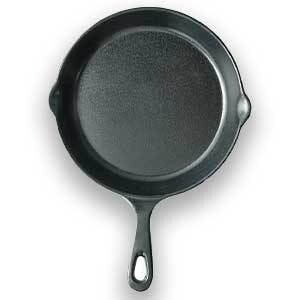 Skillets are great for all kinds of cooking tasks (from bread to cakes to fried chicken). These pans are mostly-used everyday pans that come with a lot of compelling reasons to choose them.
Skillets are great for all kinds of cooking tasks (from bread to cakes to fried chicken). These pans are mostly-used everyday pans that come with a lot of compelling reasons to choose them.
You will get a fine range of skillet sizes, they come as approximately 6-16 inches. And, about the materials, mostly steel, nonstick coatings, and cast iron are common. Cast iron skillets are heavy but they offer you the best possible heat conductivity.
These pans don’t come with high sides, rather they have sloping sides (not more than 3-4 inches). And, they have a wide opening at the top that allows you to easily toss the food ingredients. Skillets hardly come with a lid.
How to Use a Skillet
In case, you are following a strict diet chart and need to remove more fats, the nonstick characteristic will be on your side. If you regularly season your cast iron skillet, it will create a natural non-stick coating.
And, the use and maintenance of skillets is super easy. All you need to do is to preheat the pan, add butter or oil, and cook your food. That’s all!
When to Use a Skillet
- For a high-heat searing
- If you don’t want to use a lid
- For pan-frying, stir-frying, and sauteing
- If you’re eager to do a ‘chef toss’ to move the food
- Distributes heat evenly throughout the pan
- Easy to clean and maintain
- Long-lasting
- Naturally non-stick
- These pans take a bit longer time to heat up
- Cast iron skillets are heavy
2. Griddle
Griddles are another amazing addition to any kitchen. The flat cooking surface of a griddle is perfect for 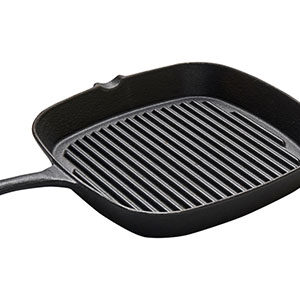 scorching vegetables and searing meats, and it is a healthy alternative to any traditional frying pan or skillet.
scorching vegetables and searing meats, and it is a healthy alternative to any traditional frying pan or skillet.
You can make pancakes, hash browns, egg items, grilled cheeses, burgers, steaks, and a whole lot more. Sounds wholesome, ha?
Griddles can come as round, rectangular, square, and various sizes. You will find a smooth surface as well as shallow sides (½ inch or less) in griddles. Those slightly raised edges work great to keep butter, oil, and other ingredients perfectly contained.
Also, they come with easy-grip handles that will allow you for better control and hanging storage. Griddles provide incredibly well heat distribution and retention for even, consistent cooking.
How to Use a Griddle
Using, cleaning, and maintaining a griddle is so simple that you will want to make the most of it. First of all, you need to set the griddle up, just put it on top of your stove.
Next, set the temperature up to the level of your desire and heat the griddle up. It will take some time to heat up. You can check if it’s heated up or not by splashing a few drops of water on it.
Then, apply vegetable oil or butter to prevent the food from being stuck. Once done, get your cooking according to the recipe.
When to Use a Griddle
- When you need a larger and easier cooking space
- If you want something for easy flipping
- If you need something to use on all cooking surface, campfires, and grills
- Cast iron griddles distribute heat very evenly
- Griddles come with a large area
- These pans ensure quick and easy flipping
- It’s a bit hard to clean griddles
- Griddles take a bit longer time to heat up
3. Dutch Oven
These are large cast-iron pots that often come with bright-colored enamel coating. As the metal is cast iron here, 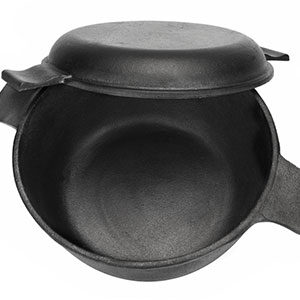 they are a bit heavy. However, dutch ovens are perfectly okay for going both in the oven and on the stovetop.
they are a bit heavy. However, dutch ovens are perfectly okay for going both in the oven and on the stovetop.
These are basically deep-sided pots that come with lids. And, you will find them extremely versatile. Moreover, dutch ovens maintain the heat incredibly well when brought up to temp.
Especially, people love to cook with dutch ovens when it comes to campsite cooking because these ovens are able to go directly over the fire pit.
These cookwares are perfect for roasting, searing, baking, browning, deep-frying, and broiling. Yes, you can make the most of a dutch oven both for roasting and baking. If you want to make an easy, one-pot meal, go for a larger size, you can literally bake a whole chicken in a dutch oven!
How to Use a Dutch Oven
Before you use a cast iron dutch oven, it’s important to prepare the surface for preventing your food from sticking or burning on it. If you are using an enameled dutch oven, then there’s no need to prepare the surface because the enamel provides a non-stick surface.
However, you have to create a cooking surface by seasoning the pan if you are using a plain-surfaced dutch oven. Once you’re done with seasoning, you can get going with any cooking.
You can easily bake, boil, roast, or sear with your dutch oven. And, you also can use the lid as a skillet or griddle. How? Well, if you need a quick fry up breakfast, just turn the oven’s lid upside down and place it on hot coals (directly).
Then cook until it’s done and watch out to make sure it doesn’t burn. You also can use this trick to fry pancakes, eggs, bacon, or sausages.
When to Use a Dutch Oven
- When you need to cook joints of the meal (there’s no chance of getting an under-cooked spot once you finally cut the joint).
- If you want a tight-fitting lid that aids to trap moisture into your dutch oven.
- When you need something to use both in the oven and on the stove
- It conducts heat incredibly well.
- Thick walls of dutch ovens radiate the heat evenly.
- For the tight-fitting lid, foods will not dry out.
- The whole pot can be placed directly from the stovetop to the oven.
- The enamel coating makes it easy to clean.
- Enamel interior makes dutch ovens a little harder to monitor the browning process.
- The too tight-fitting lid may compel you to reduce the cooking liquids to concentrate the flavors.
4. Wok
For people who love Asian cooking, the wok is a must-have kitchen appliance. If you are a fan of steamed 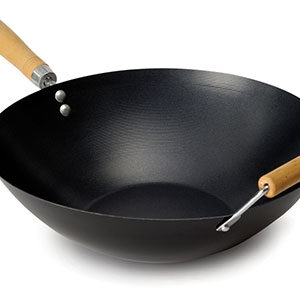 dumplings, smoked chicken wings, spicy stir fry recipes, or fried wontons, this traditional pan is enough to make all of your favorite dishes.
dumplings, smoked chicken wings, spicy stir fry recipes, or fried wontons, this traditional pan is enough to make all of your favorite dishes.
These pans are usually used for Chinese cooking. Generally, they come with round bottoms, this is the most common and traditional shape. But in recent years, flat bottoms of the wok are seen as well in the market.
When you cook on a gas stove, woks with a round bottom are perfectly okay. But when it’s about electric stoves, you need the stokes with flat bottoms.
If you want to buy a family-sized cast iron wok, then go for one that is 14-inches in diameter. And, if you are looking for a wok you want to carry while traveling, then an 8-inches wok should be your pick.
Moreover, there are varieties in the type of handles. The mostly-chosen and easiest-to-toss type of handle is a long stick handle.
How to Use a Wok
Right after you buy a wok, it’s important to scrub off the protective coating that comes with new woks. This coating helps to keep the woks fresh while the woks are in the store.
So, you need to scrub it using soap and water and then dry it using a towel to remove that protective coating. After that, put your new wok on the stove on medium heat and let any moisture evaporate. It will help to prevent rusting as well.
Then, you need to season the wok and let it get ready for cooking. Once it’s ready, preheat the wok, add cooking oil and get cooking. And, try to keep ingredients cooking in batches to avoid overcrowding.
When to Use a Wok
- When you’re looking for something perfect for stir-frying vegetables and meats
- If you want to cook Chinese dishes most perfectly
- When you need to shorten the cooking time
- It’s too easy to toss the food using a wok.
- It’s easy to control the heat while using a gas stove (this is crucial for stir-frying).
- Cast-iron woks are perfect for use on any stovetop (e.g on gas, electric induction) and even in the oven.
- It requires more care- proper washing, seasoning, and drying.
- It can generate a lot of smoke while cooking.
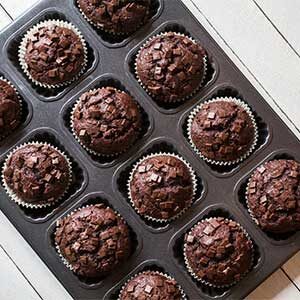 5. Muffin Pan
5. Muffin Pan
If you are looking for the best tool that makes delicious muffins and cornbread, here is your cup of tea. It’s also a great choice for baking quiches, sliders, mini lasagnas, and meatloaves.
Generally, these pans come in a small size- it is not a perfect place to pick this pan when it’s about out of the oven. Also, muffin pans are quite heavy as well.
However, using a muffin pan is quite easy. You need to preheat the pan and brush a bit of butter on its surface before you bake. Once the baking is done, you will see the muffins come out crispy.
How to Use it
When you are dealing with a new muffin pan, go through a decent washing, drying, oiling, and baking process. After that, your cast iron muffin pan is ready to get cooking.
Then you need to preheat the pan at a perfect temperature. Wipe some butter in the muffin slots of your hot pan. And, fill every slot using butter to about 2/3rds full. When everything is okay, bake.
This is all about using a muffin pan. Once you’re done, make sure you clean it properly and store it in a dry place.
When to Use it
- If you want your muffins to come out just perfectly
- When you need something easy-to-clean
- Cast-iron muffin pans make the world-class muffins
- It’s easy to clean and maintain
- It ensures you having healthy baking
- For the cast-iron material, you will find it heavy
Things to Consider Before Buying a Cookware
Here are a few tips you should know before buying a cast iron cookware.
- Cast iron products are heavy. It is crucial to keep the weight fact in mind before you purchase cookware. And, the larger your pan is, the heavier it is. However, the heavier items hold more heat and offer you to have an authentic iron cooking style. So, think if you are okay with these facts before buying a cast iron cookware.
- Examine the handles and knobs of the cookware you are going to purchase. Luckily, cast iron cookware comes with user-friendly handles or knobs and there’s less risk. Look carefully if the cookware has a heat-resistant cover before buying one.
- Make sure the coating of your new cookware’s surface is thick enough. Otherwise, it will scratch by cooking utensils. Also, uneven coatings create problems in even heat distribution.
Conclusion
So, this is all about today’s discussion. Hopefully, by reading this article, you have got a crystal clear idea about the different types of cast iron cookware.
Here, we have talked about the most common types of cast iron cookware. Keep everything in your mind and purchase your cookware carefully. And, once you buy the desired one, make sure you use and maintain it properly.
Good luck Dear!



